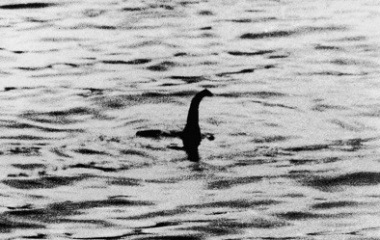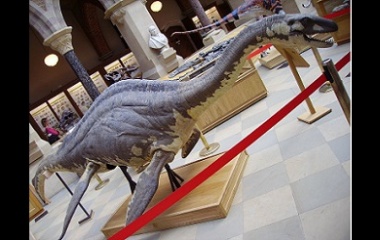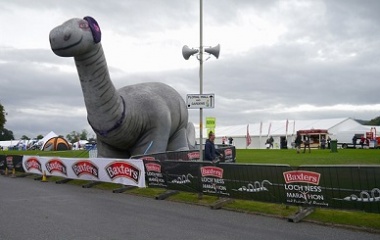What is the Loch Ness Monster?
One of the most charismatic monsters of our time, the Loch Ness Monster (or Nessie) draws thousands of tourists each year to the dark shores of Scotland’s Loch Ness. Little can be proven about this water-dwelling beast, but cryptozoologists aren’t ready to let her sink into oblivion just yet!
Characteristics
Physical Description
The Loch Ness Monster is a huge, water-dwelling creature, perhaps over 40 feet long! She has a long, thin neck and a small, snake-like head. Her skin is dark green or black, with a slippery sheen that helps her camouflage herself in the murky water.
When Nessie is spotted, the bulk of her body is usually submerged. Still, scholars have speculated about what lies hidden below the water. Most people believe she has a round body with four, powerful flippers and a tapering tail. A few people believe she is more serpentine and lacks flippers.
Most witnesses recognize Nessie as a series of humps, cutting swiftly through the water. She is sometimes seen splashing or leaving huge ripples in her wake.
Habitat and Behavior
The Loch Ness Monster is, as you might have guessed, a native of Loch Ness. This lake is a unique oasis, tucked away in the Scottish highlands. Spanning 22 square miles and 755 feet in depth, it contains more water than all the other lakes in the United Kingdom combined. It’s size makes it the perfect hiding place for a monster—although surrounding Scottish lakes have also reported mysterious creatures, which suggests that the Loch Ness Monster might actually be a group of animals, scattered across the region.
Nessie is a shy creature, rarely venturing out of her hiding holes in the depths of Loch Ness. Still, some witnesses have described Nessie swimming up rivers, basking on the lake shore, or even “lumbering” across roads, so it’s safe to assume that she can survive outside of the watery depths.
Her diet is less clear. Some witnesses have seen her with large prey grasped in her mouth, and others have described her thrashing about in the water, as if she was attacking prey. Others have suggested that she is a bottom-feeder, who dines on plankton and mollusks, which would explain why she is rarely sighted and why she has never attacked a human or been caught disturbing fishing nets.
It’s possible that Nessie uses a type of echolocation to navigate her dark world or to catch prey. Sonar investigations have picked up a few, unexplained noises in the depths of the lake.
Evidence
Sightings
The first monster story to emerge from Loch Ness dates back to 565 AD. A saint was passing through the area when he saw a village person burying a dead man by the river. The saint asked what had happened, and the villager reported that a “water beast” had mauled the man. Intrigued, the saint commanded one of his followers to swim into the beast’s territory. Within minutes, the monster appeared to claim a second victim, but when the saint invoked God’s name, it fled back into the waters.
Nothing more was said of Nessie for almost 1400 years. Then, in 1933, a local couple was driving home one evening when they saw a creature “like a huge snail with a long neck” crossing the road in the distance. The bulky creature managed to lug itself across the road, then into the lake, before the coupled reached it. They wrote a letter to the newspaper about their bizarre encounter, and that letter sparked a flood of similar reports.
In 1934, the Loch Ness Monster was photographed for the first time. Although blurry, the photo, which appeared to capture the inky silhouette of a long neck and humped back, convinced millions of people. To date, it is Nessie’s most famous portrait.
More photos and stories of Nessie rolled in, including reports from local policemen, fishermen with sonar equipment, and environmental activists, but the world had to wait until 1960 for their first Nessie video. Again, the footage was blurry and the object was distant, but it was enough to excite the Loch Ness Monster’s growing fanbase.
In 1977, the first, detailed photo of Nessie surfaced. This photo appeared to be close-range; it even revealed the glossy coloration of the monster’s skin. Surprisingly, this photo received more backlash than any of its blurry predecessors. It was mocked as “the Loch Ness Muppet,” even by people who believed in Nessie.
In 2014, satellite images became publicly available. Not surprisingly, believers in the Loch Ness Monster were eager to turn this advent to the hunt. Soon, satellite photographs of Nessie were circulating on the internet; sadly, they were just as distant, indistinct as the first, grainy image caught in 1934.
Searches
Shortly after the first Nessie photo was released in 1934, teams of researchers began flocking to Loch Ness. They staked out the shoreline with binoculars and cameras, hoping to catch the next iconic image of the monster. Unfortunately, they weren’t able to produce any compelling evidence.
In 1967, research teams began using sonar to search for the creature where it spent most of its time: underwater. The sonar images revealed several, unidentifiable shapes in the lake, which moved in a strange pattern at a high speed.
In 1972, an innovative expedition added underwater cameras to their sonar devices. Whenever a mysterious object was contact, the cameras took a photograph. They produced a number of strange, indefinite photographs. The expedition was repeated in 1975, 2001, and 2008, each time adding to the collection of strange photographs—which some people believe show Nessie in her natural habitat.
In 2003, the BBC put together a fleet of boats with 600, high-powered sonars and satellite tracking devices. They scanned the lake from end to end, without finding anything that might suggest a massive predator lurking in the water.
Explanation
Today, most people consider the Loch Ness Monster to be nothing more than a charming, Scottish folktale. Sightings and photographs are usually dismissed as cases of mistaken identity, or clever hoaxes, at best. From a distance, a floating log, a group of seals or otters, or even just a wave could be mistaken as the famous monster, of whom everyone is eager to catch a glimpse.
Still, many people have remained loyal to the Loch Ness Monster’s legend. Most believe that the Nessie is a type of dinosaur, called a plesiosaur, which has somehow managed to survive in the Scottish highlands. A few scientists believe that Nessie is, in fact, a Greenland shark, which has been documented around Iceland and Norway, although never seen in Scotland.
Loch Ness Monster






No comments:
Post a Comment